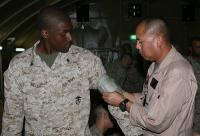-
CRISIS PREPARATIONCrisis-Preparation Lessons from COVID-19
The early months of COVID-19 tested the UK’s highly regarded crisis management capabilities to their limit. The UK’s crisis management system was designed for, and practiced at, managing much shorter, more localized emergencies. There was no preparation for large-scale testing; no detailed planning for the economic consequences of a medical catastrophe; and no detailed plans in place for the possibility of school closures.
-
-
FloodsHow Do We Prepare for Extreme Flooding?
As the floodwaters recede following the devastating deluge in western Europe, survivors have begun the long, difficult process of cleaning up and rebuilding. But what can be done to reduce future risks?
-
-
Infection rateGerman Study Suggests Infections Are 10 Times the Number of Confirmed Cases
More than 10 times as many people in Germany have likely been infected with the coronavirus than the number of confirmed cases, researchers from the University of Bonn have concluded from a field trial in one of the worst hit towns. Thilo Schmuelgen writes for Reuters that The preliminary study results, which have yet to be peer reviewed for publication in a scientific journal, serve as a reminder of the dangers of infection by unidentified carriers of the virus, some of whom show no symptoms, the researchers said.
-
-
ChloroquineNigeria Reports Poisonings from Possible Coronavirus Drug Chloroquine
Nigeria on Sunday warned about cases of chloroquine poisoning after the anti-Malaria drug was hailed as a possible cure for coronavirus, according to a report. The New York Post reports that President Donald Trump tweeted on Saturday that “HYDROXYCHLOROQUINE & AZITHROMYCIN, taken together, have a real chance to be one of the biggest game changers in the history of medicine.”
-
-
911He got mugged, then revamped 911 for the next generation
Israeli company Carbyne has re-engineered the infrastructure for 911 services from the ground up, to take advantage of all the innovations that have come along in the 20 to 30 years since most emergency systems were built. Those innovations include the ability to see the location of a caller on a map, to chat by text if a voice call is not possible, to use VoIP (Voice over IP) services like WhatsApp and Skype, and to stream video so the 911 operator can see what’s happening in real time.
-
-
PandemicsThree reasons the U.S. is not ready for the next pandemic
In the midst of a pandemic, decisions must be made quickly. Quick decision-making can often be hindered by the absence of high-level leadership. The need for high-level leadership, coordination and a new strategy are essential to mitigate the threat of pandemics, but these fundamental pandemic preparedness gaps persist. The next great pandemic is coming. The true question is: Will we be ready when it does? Right now, that answer is no, because the country lacks the sufficient safeguards we have outlined. But if the United States chooses to elevate the issue of pandemic preparedness and biosecurity as a national security priority, we could be. Outbreaks are inevitable, but pandemics are not if we take action now.
-
-
First respondersTraining bystanders to act as first responders
Blood loss is the leading cause of preventable death during an active shooter or intentional mass casualty event where a medical response is delayed. To educate the public – who often find themselves on the front line in emergency situations – a team led by a trauma surgeon from Rutgers New Jersey Medical School and EMS from University Hospital are directing the largest Stop the Bleed campaign in the state, teaching laypeople basic skills of hemorrhage control for immediate, on-the-scene care.
-
-
First respondersNew tool for first responders: An ice bag to the face
A new study suggests a simple bag of ice water applied to the face could help maintain adequate blood pressure in people who have suffered significant blood loss. the researchers’ aim is to help prevent cardiovascular decompensation, a sudden precipitous drop in blood pressure that limits oxygen delivery to the heart, brain, and other vital organs. Decompensation is a significant risk after blood loss, even once the person is no longer actively bleeding.
-
-
Trauma careIntegrating military, civilian trauma care systems could prevent up to 20% of U.S. trauma deaths
The leading cause of death for Americans under the age of 46 is trauma — a disabling or life-threatening physical injury that results from an event such as a motor vehicle crash, gun violence, or fall. In 2013, trauma cost approximately $670 billion in medical care expenses and lost productivity. Of the 147,790 U.S. trauma deaths in 2014, as many as 20 percent — or about 30,000 — may have been preventable after injury with optimal trauma care. Mass casualty incidents and increasing foreign and domestic threats to homeland security lend urgency to the translation of wartime lessons to civilian trauma systems, says a new report.
-
-
EMSIsrael EMS team trains Panamanian medics for terror attack
United Hatzalah, the national volunteer EMS service in Israel, sent a delegation of EMTs, paramedics, doctors, and logistics personnel to Panama to train their counterparts in providing the proper response for a Mass Casualty Incident (MCI).
-
-
First respondersParamedics' risk of being assaulted far exceeds risk to firefighting colleagues
Research found that y medical technicians and paramedics are fourteen times more likely to be violently injured on the job than the firefighters they work alongside. The researchers found that assault-related injuries are often not reported, not acknowledged by administration, and therefore they are internalized by the workers as a “part of the job.”
-
-
First respondersParamedics' risk of being assaulted far exceeds risk to firefighting colleagues

Research found that y medical technicians and paramedics are fourteen times more likely to be violently injured on the job than the firefighters they work alongside. The researchers found that assault-related injuries are often not reported, not acknowledged by administration, and therefore they are internalized by the workers as a “part of the job.”
-
-
Health emergenciesSharing of research data, findings should be the norm in public health emergencies

Opting in to data sharing should be the default practice during public health emergencies, such as the recent Ebola epidemic, and barriers to sharing data and findings should be removed to ensure those responding to the emergency have the best available evidence at hand, experts say.
-
-
First responseU.S., Israel to co-develop technologies for first responders

Some $12 million will be funneled to collaborative Israeli-American projects for the development of advanced technologies for first responders over the next three years. The agreement brings together the Israeli Ministry of Public Security and the U.S. Department of Homeland Security in a drive to better equip and prepare both countries’ national rescue forces including fire, police, and first-aid units. Each side will invest equally in the project.
-
-
First responseFDA clears military traumatic wound dressing for use in civilian population
Early control of severe bleeding may prevent shock and may be life-saving., as 30 to 40 percent of civilian deaths by traumatic injury are the result of hemorrhaging. Of those deaths, 33 to 56 percent occur before the patient reaches a hospital. Last week the FDA cleared the use of the XSTAT 30 wound dressing, an expandable, multi-sponge dressing used to control severe, life-threatening bleeding from wounds in areas that a tourniquet cannot be placed (such as the groin or armpit) in battlefield and civilian trauma settings.
-
- All
- Regional
- Water
- Biometrics
- Borders/Immig
- Business
- Cybersecurity
- Detection
- Disasters
- Government
- Infrastructure
- International
- Public health
- Public Safety
- Communication interoperabillity
- Emergency services
- Emergency medical services
- Fire
- First response
- IEDs
- Law Enforcement
- Law Enforcement Technology
- Military technology
- Nonlethal weapons
- Nuclear weapons
- Personal protection equipment
- Police
- Notification /alert systems
- Situational awareness
- Weapons systems
- Sci-Tech
- Sector Reports
- Surveillance
- Transportation
Advertising & Marketing: advertise@newswirepubs.com
Editorial: editor@newswirepubs.com
General: info@newswirepubs.com
2010-2011 © News Wire Publications, LLC News Wire Publications, LLC
220 Old Country Road | Suite 200 | Mineola | New York | 11501
Permissions and Policies
Editorial: editor@newswirepubs.com
General: info@newswirepubs.com
2010-2011 © News Wire Publications, LLC News Wire Publications, LLC
220 Old Country Road | Suite 200 | Mineola | New York | 11501
Permissions and Policies
